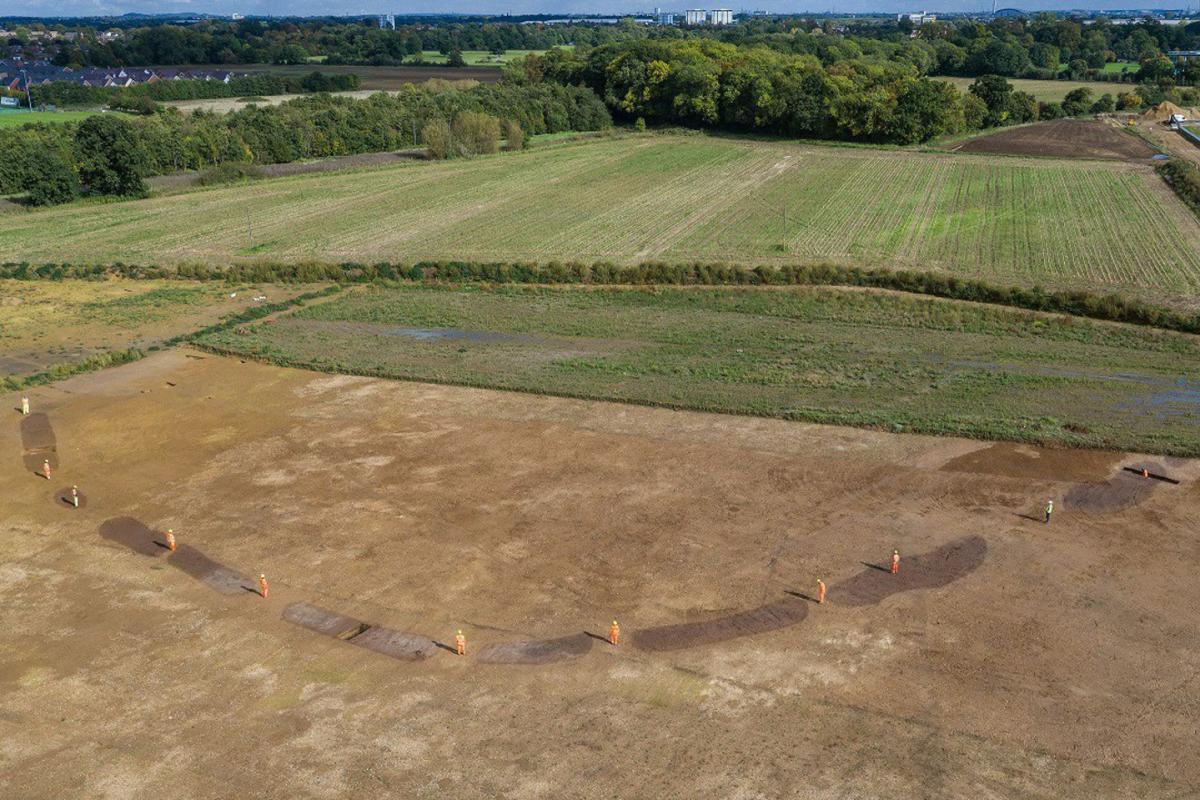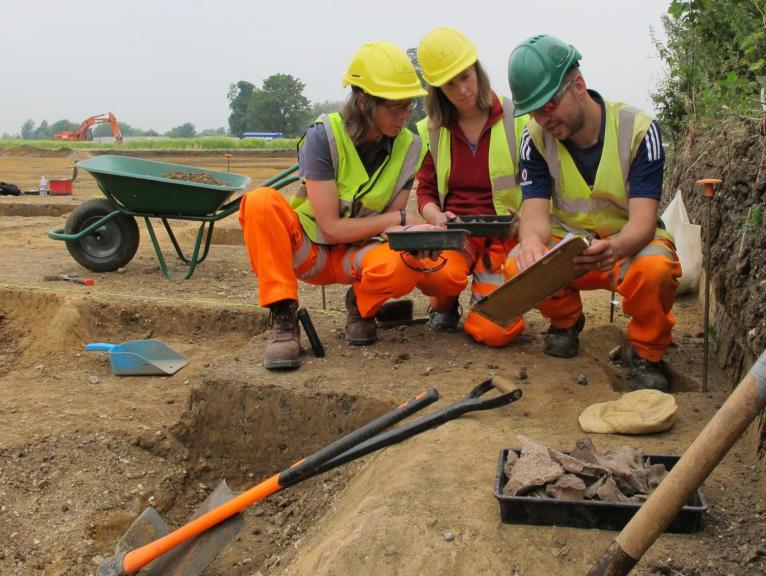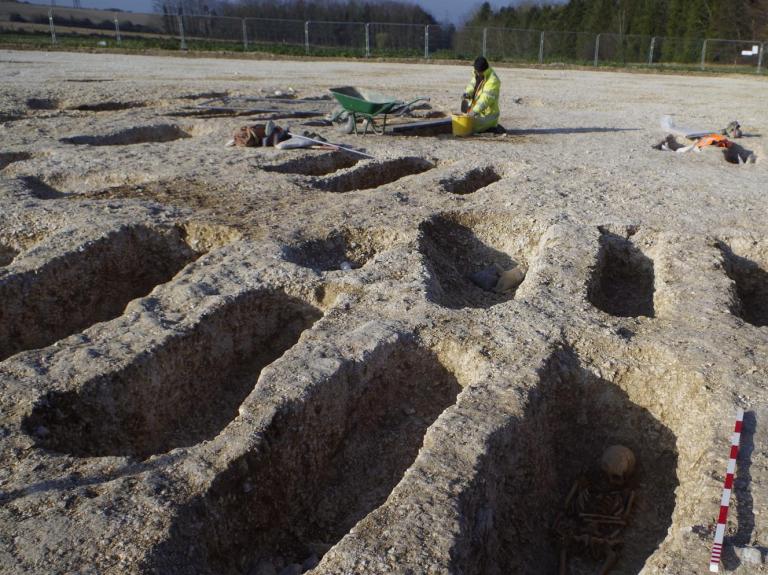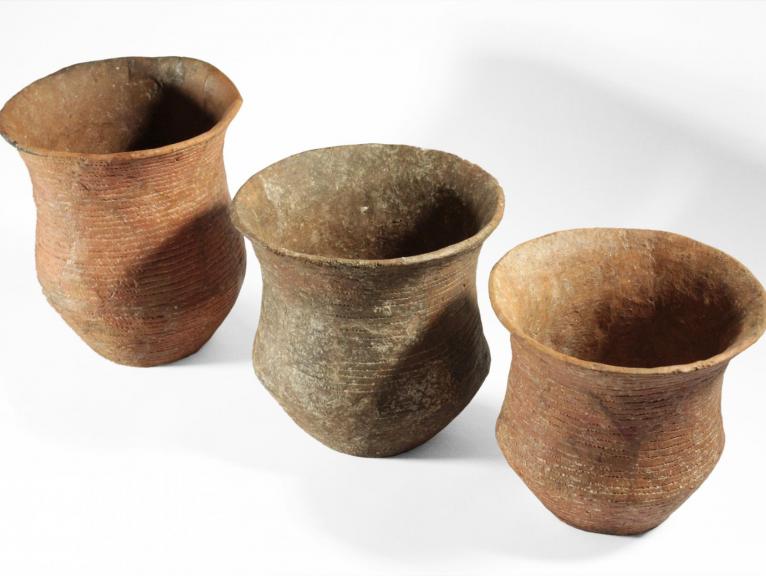51.486154968775, -0.57959385216236
Within sight of Windsor Castle, a team of archaeologists from Wessex Archaeology are undertaking an excavation in advance of sand and gravel extraction at CEMEX UK’s new quarry at Riding Court Farm, Datchet, Berkshire. The new quarry site contains archaeological remains from multiple periods providing evidence that people have occupied, settled, farmed and altered the landscape since the end of the last Ice Age, a period of 12,000 years.
The Challenge
Works at the quarry involve the extraction of sand and gravel over a 41-hectare area just to the north of the village of Datchet, Berkshire, with the project intended to take 5+ years. An additional access route and spoil bunds designed to prevent noise and dust will also be required as part of the works.
The site is located between Datchet and Slough, with the M4 motorway bordering the site along the southern boundary. This area of lies the Thames Valley is rich in archaeological remains. The earliest known activity in the area relates to the Mesolithic, and over 50 stone and bronze weapons and tools have also been found in the nearby section of the River Thames which are thought to reflect ritual deposition during the prehistoric period. Excavations in the area have uncovered a range of activities dating from the Neolithic through to the post-medieval period with evidence of occupation in the Iron Age, Romano-British and Anglo-Saxon periods. In the wider area excavations have revealed extensive activity from the Neolithic onwards, especially in the Middle Bronze Age when large areas of the landscape were cleared and sub-divided in to fields of a farming landscape.
Medieval settlement activity has been identified at Riding Court Farm, Datchet village, Ditton Park and Upton Court and it has been suggested that there could have been a separate settlement at Riding Court Farm as early as the 12th century. Ditton Park, a parkland which lies to the north-east of the site, is documented from the medieval period but was enlarged rapidly during the 17th century. The 18th century even saw the involvement of Lancelot ‘Capability’ Brown in the design of the park.
Once the entire site has been investigated we will be able to view the archaeology on a landscape scale enabling us to understand how humans used the site throughout history.
Our Approach
The site has already been subject to a number of archaeological investigations including a desk-based assessment, air photo assessment, geophysical survey and trial trench evaluation. The earlier evaluation work indicated that a Romano-British farmstead may have occupied the southern edge of the site and is due to be excavated in future seasons. At the north-western edge of the quarry, ditches, pits and an oven suggest further Romano-British (AD 43–410) activity lies just beyond the edge of the site.
Archaeological investigations at Riding Court Farm will continue yearly ahead of proposed quarry extraction areas and with the continued vital support of CEMEX UK and The Guildhouse Consultancy. Archaeologists have been working on the site since November 2015.
This is such an exciting and important discovery in the Royal Borough. The excavation of this monument will add so much to our shared human story, especially at this pivotal time in the earliest years of farming in Britain.
Our Results
At the end of the last Ice Age people began to exploit the British landscape and this area of the Middle Thames Valley contains some of the earliest examples of hunting camps and occupation. The earliest artefacts found on the site so far dates to the Mesolithic period (8500–4000 BC) and includes a fragment of a skilfully worked flint axe. This beautiful yet functional object provides a link to the daily life of hunter-gatherers in the Middle Thames Valley who were adept at using such tools whilst procuring resources in this landscape, which they probably only seasonally visited.
During the Neolithic period in Britain farming was introduced and people began to leave visible traces on the landscape of the Middle Thames Valley with the construction of ceremonial monuments and settlements. During the Neolithic the surrounding area contained a monument complex that included a cursus, ring ditches, oval barrows and causewayed enclosures. The monuments had developed alongside the Thames, one of the great rivers of Britain that acted as both a barrier, gateway and routeway to other regions. The 2017 investigations at Riding Court Farm have provided evidence for Early Neolithic activity (4000–3350 BC) with the discovery of a previously unknown causewayed enclosure.
The causewayed enclosure, defined by an encircling interrupted ditch with entrances, represents one of the earliest known acts of monument building in Britain. The function of such monuments remains uncertain but the act of enclosing an area by physically altering the landscape suggests a significant change in the relationship of earlier farming communities and their ties to the land. Such enclosures have been found across Britain (mainly concentrated in the south) and also on the Continent. The Riding Court causewayed enclosure comprises a single circuit of interrupted ditches, which in places became the focus for deposits of human and animal bone, pottery and worked flints. In total around 255 m of the enclosure’s arc – some 13 ditch segments – has been mapped and further segments lie to the east and will be excavated in future years.

Close to the monument a cluster of pits and a ditch have been excavated, and they contained Early Neolithic pottery, worked stone tools including a flint scraper and a hammerstone, as well as polished flint waste flakes from reworking or sharpening tools. Some of the worked stone comes from the axe factory at Great Langdale in the Lake District; such finds illustrate that the communities of Datchet had long distance connections during the Neolithic period. Further pits containing finely decorated Middle and Late Neolithic pottery illustrate the continued occupation of the site throughout the Neolithic period.
Organised large-scale field systems and contemporary settlements are known to have developed in the Middle Thames Valley in the Bronze Age (2200–700 BC). Such field systems, associated pits and postholes forming structures have been uncovered at the new quarry site. One large watering hole contained the remains of a number of decorated Middle Bronze Age vessels which included a large Barrel Urn and these may have been deliberately deposited in a symbolic act. Another contained a well-preserved timber planked box at its base, outside the box a human skull had been placed, possibly as a closing deposit. Cattle and horse burials have been found in several ditch terminals and large spreads of broken pottery vessels were made on the base of some ditches. One field boundary was the focus for three human burials and two cattle burials. These deposits could indicate the edges of a settlement areas or a change in land use and ownership.
There is little evidence for Romano-British activity in the local area but it is likely that the site played a role in the rural economy of the wider area. Earlier evaluation work identified two Romano-British features towards the southern edge of the quarry. Excavations in 2016 produced evidence for a probable Romano-British field system, which may have been linked to a farmstead thought to lie to the north-west of the quarry. Romano-British finds increased towards the north-western edge of the quarry and included an oven that contained quernstones in its backfill and a number of field ditches and pits. Roman pottery and roofing tiles were found in the ditches and animals had been buried in the top of one of the ditches.
The site probably continued to be used for agricultural land throughout the medieval period. The earliest references to the village of Datchet are from AD 994 and record the sale and exchange of land. To the north of the site Ditton Park, a moated country house, was occupied before 1066 and was valued at £2 in the Domesday Survey. A large field boundary that crosses the western part of the site may have medieval origins. The boundary follows a slight change in topography and appears to have followed earlier Bronze Age and Roman boundaries and was itself redefined in the post-medieval period. The 1833 enclosure map records the field to the south of the boundary as ‘Swine Mead’ which might suggest that the area was used to house pigs or that it was marginal or unpleasant land.
Also, shown on historic mapping is the route of Whites Lane, the lane is shown on maps dating back to 1752. The lane is still in use today to the south of the M4 as a residential street and its course is shown on historic maps running across the north-west part of the quarry. Archaeologists discovered that Whites Lane was preserved below the topsoil as a metalled surface flanked by two ditches.
CEMEX UK has been extremely conscientious in addressing the archaeology of this site and I applaud their commitment to ensuring this ancient prehistoric monument will be thoroughly investigated by Wessex Archaeology.
6 years of mineral extraction
41 hectares to be investigated
12,000 years of human occupation evidence


